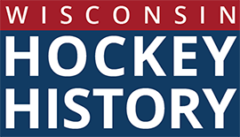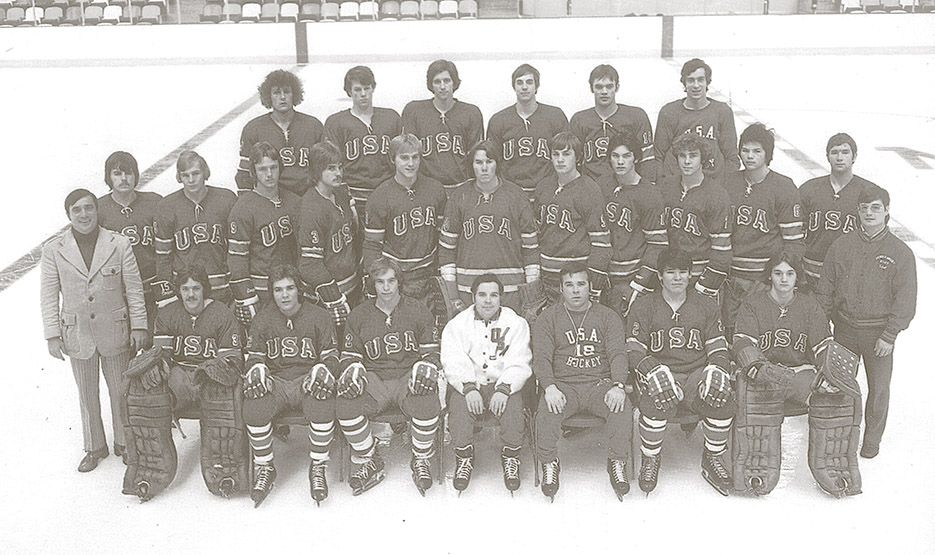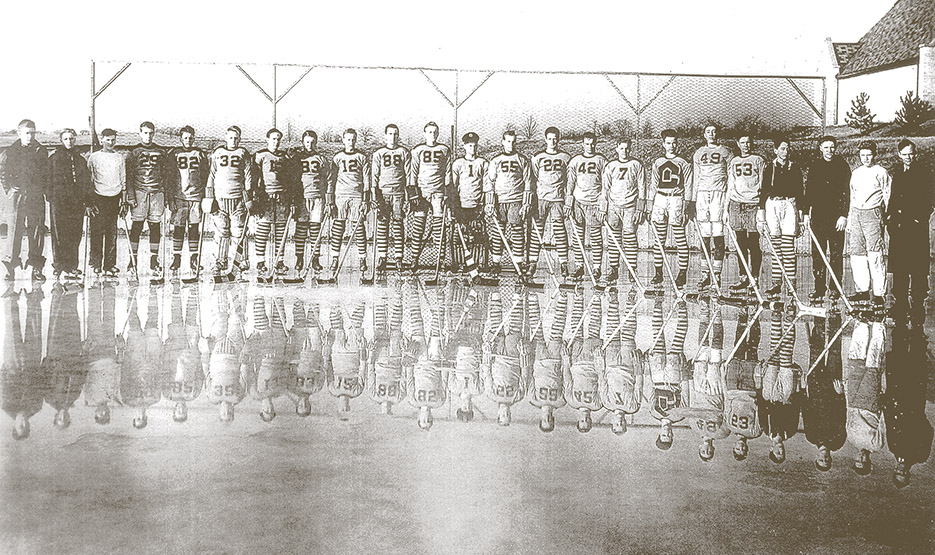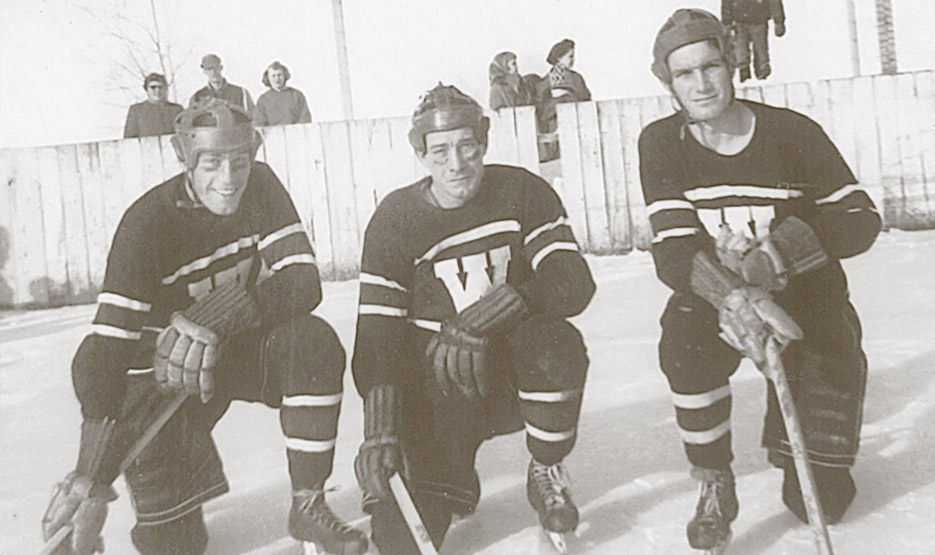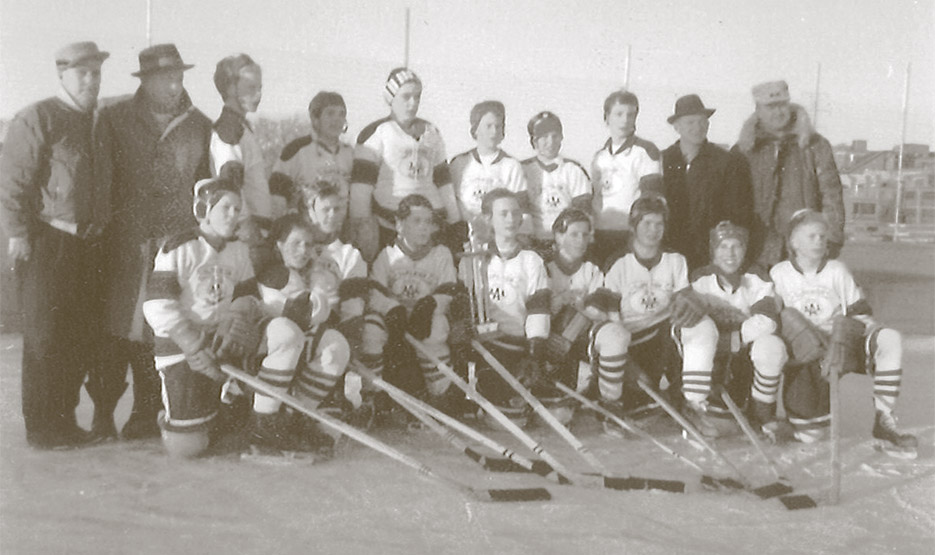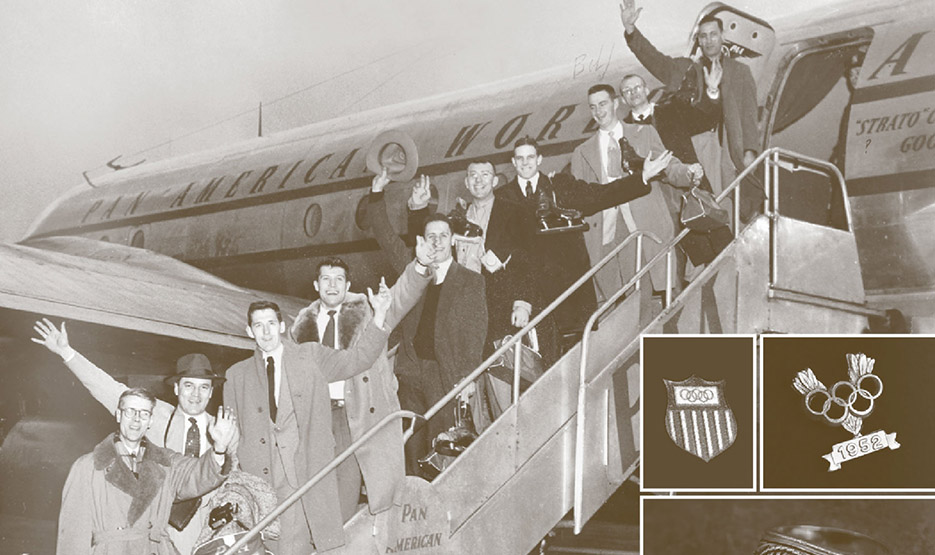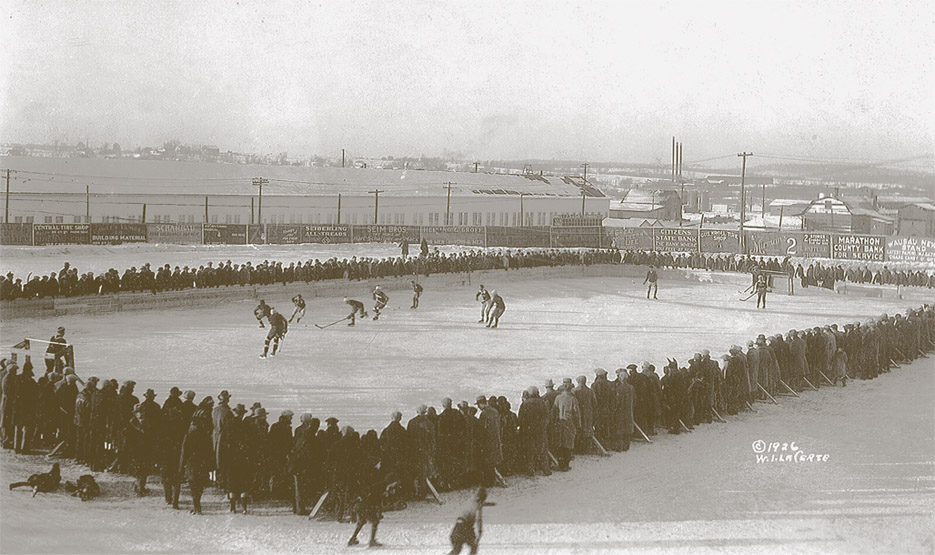This article written by Don Clark of Cumberland, appeared in a December 1982 issue of Wisconsin’s Hockey Exchange. It does a great job of tracing all aspects of hockey development in the state. Don Clark was inducted into the Wisconsin Hockey Hall of Fame in 1978. He was also instrumental in promoting hockey in Minnesota and throughout the United States and was inducted in the United States Hockey Hall of Fame also in 1978.
From the records available, it appears the first organized hockey in Wisconsin was played in Superior in the late 1890s. Superior assembled a club and played against Duluth and Two Harbors teams. Apparently the game of ice hockey in the Head of the Lakes was an outgrowth of ice polo, a very popular game in St. Paul and Duluth as far back as the mid-eighties.
By 1911 Eau Claire was icing a team and met teams from St. Paul and eastern Minnesota in competition. In 1916 Green Bay had organized a 4-team city league and also on occasion met other teams from the Fox River Valley area.
Milwaukee was the first Wisconsin city to play hockey on a big time basis, when in 1923 they joined the USAHA, the other strongest circuit in the United States at the time. Other members of the league were: Cleveland, Pittsburgh, St. Paul, Eveleth and Duluth. The Milwaukee team, an imported aggregation, proved to be a poor draw and the sport died following the 1923 season.
Fox Valley League Formed
In 1923, the Fox River Valley league was formed with teams from Oshkosh, Neenah, Menasha, Fond du Lac and Appleton as members. Oshkosh was the perennial champion in the early years of the league. About the same time another league was formed in southern Wisconsin known as the Rock River league and composed of teams from Madison, Janesville, Jefferson, Fort Atkinson and Watertown.
In February of 1930, the Wisconsin State Amateur Hockey association was organized in place of the old Wisconsin State Hockey league. Officers elected were: President- John Farquhar, Madison; Secretary- A.E. Bergman- Janesville; and Treasurer- Sid Goldstine, Madison. Teams that signified intentions of joining the newly formed association were: Madison, Milwaukee, Janesville, Manitowoc, Jefferson, Watertown, Fort Atkinson, Kenosha, Racine, Beloit, Eau Claire, Chippewa Falls, Lake Mills, Lake Geneva, Wisconsin Rapids, Beaver Dam and Rockford, Illinois.
By the late 1920s hockey was also being played in the northwest section of the state with teams from Rice Lake, Cumberland, Webster, Spooner, St. Croix Falls, Grantsburg, Solon Springs, and Frederic meeting one another in inter-city and tournament competition. Other Wisconsin communities that iced teams by the early 1930s were Rhinelander, Wausau, Eagle River, Superior, Marinette and LaCrosse. Janesville had a well-organized program for the younger boys at this time with 14 teams divided into two leagues- lightweights and middleweights. This was probably the first successful boys’ hockey program in the state. Janesville was also instrumental in introducing the sport to such cities as Beloit, Fort Atkinson and Rockford, Illinois.
Prep Hockey Begins
By 1930, hockey was becoming popular in the high school and prep schools in the state. At this time Shorewood and Country Day of Milwaukee, Milwaukee Lincoln, St. Johns of Delafield, Northwestern Military of Lake Geneva, Appleton, Lake Geneva and Ashland played a regular schedule of games. Ashland played a schedule against Duluth and Iron Range schools from Minnesota. By the late 1930s, the following schools in addition to the above were sponsoring teams: Marquette, Messmer, Pio Nono of Milwaukee, Wausau, Madison West, Medford, Stevens Point, Merrill, Wisconsin Rapids, Wauwatosa, Waupaca, Marshfield, Antigo and Nekoosa.
During the thirties and up until World War II Eagle River and Wausau consistently iced the strongest amateur teams in the state. Eagle River, a small community in northern Wisconsin and possessing at that time the only enclosed rink in the state, captured six consecutive state championships. The teams under the tutelage of Connie Pleban of Eveleth, Minnesota and composed chiefly of players from the Iron Range region of Minnesota, were probably the strongest amateur sextets to represent the state with the possible exception of the 1923 Milwaukee team of the USAHA and the strong Marquette University teams of the twenties.
In this same era Fond du Lac, Marshfield and Chippewa Falls also fielded strong teams, but none had the consistently powerful teams as those representing Eagle River and Wausau.
Any discussion of Wisconsin hockey would be incomplete without some mention of the strong teams representing Marquette University and the University of Wisconsin in the twenties and the thirties. During this period it was usually Marquette and Minnesota battling it out for mid-west supremacy. Marquette’s most powerful teams were during the period when Don McFayden and Clarence MacKenzie, both from Calgary, Alberta were leading the club. Hockey was popular at Marquette University with crowds of 1500-2500 watching the games on outdoor ice. The University of Wisconsin also had some good teams during this period, although they did not attain the success that Marquette attained. During the depression of the early thirties hockey was dropped at both institutions and not revived until the 1960s by the University of Wisconsin.
World War II Interrupts Hockey Activity
World War II, coupled with the lack of proper playing facilities in many areas of the state, dealt a severe blow to hockey in Wisconsin. Most of the high schools and many of the amateur teams suspended operations, many of them never to revive the sport. Appraising the situation, A.E. German of Beaver Dam called a meeting of hockey leaders in Beaver Dam in 1947 for the purpose of reviving the Wisconsin Amateur Hockey Association. In the next few years, under the leadership of Bud Bellon of Horicon and R.J. Van Adestine of Green Bay, the sport began a slow revival.
In 1960 Joe Leszcynski, Superior and Fenton Kelsey Jr., Madison were elected to the offices of president and secretary, respectively of the Wisconsin Amateur Hockey Association. Under the guidance of these two individuals WAHA has worked diligently to promote hockey, and has been especially active in the youth category.
Since 1960, WAHA has sponsored state wide youth hockey tournaments. With youth hockey once again developing in the state in the 1960s, a state high school tournament was held. Eagle River won the first invitational tournament defeating Madison West 4-3 in the finals at Madison’s Hartmeyer Arena in 1964. In 1971, the invitational tournament was officially replaced by the WIAA sponsored tournament. From 1965-1980, only three schools- Superior (7), Madison East (6) and Madison Memorial (4) won titles.
In 1960 only four ice arenas existed in the state- Eagle River, Superior, Madison and Green Bay. By 1970, there were still less than 10 indoor artificial ice arenas. But, the sport of hockey was growing due to many outdoor, natural ice programs. Indoor ice facilities ice facilities increased greatly during the decade of the ‘70s. Indoor rinks numbered 34 by 1980. Most had installed artificial ice.
The University of Wisconsin dropped varsity hockey after the 1934 season and did not revive the sport until the1963-64 season. John Riley, Madison attorney, coached the first few teams. Bob Johnson, a native of Minneapolis who played college hockey at Minnesota assumed the coaching reins for the 1966-67 season. During his fifteen- year tenure at Wisconsin, Johnson amassed a 367-175-23 record. Johnson’s teams won three NCAA Division I titles. His winning record at the University, where his teams perennially led the nation in college attendance, and his promotion of the game statewide has had a great influence on the growth of the sport in the state.
By the early 1980s college hockey was played at Superior, Stout, Eau Claire, River Falls and Steven Point- all members of the Wisconsin State University Conference. Many of the players rostered on these teams advanced through WAHA and high school programs.
It has been through the cooperative efforts of WAHA, the schools/colleges and the dedication of many volunteer individuals that hockey has finally emerged as a leading sport in the state.
Notes:
- John Farquhar, the first president of the Wisconsin Amateur Hockey Association in 1930, was originally from Winnipeg. He coached the University of Wisconsin from 1927-1930.
- Bud Bellon and R.J.(Red) Van Adestine who were instrumental in reviving the state association were inducted to the Wisconsin Hockey Hall of Fame in 1988 and 1975, respectivley
- Fenton Kelsey (1975) and Joe Leszcynski (1976) were also inducted into the Wisconsin Hockey Hall of Fame. As were John Riley (1975) and Bob Johnson (1987).
Updates
In 1980, there were 34 WIAA boys’ high school hockey programs. In 2014, 90 teams representing close to 130 schools sponsored the sport. During the 1980s, Superior (2), Madison East, Madison Memorial (3) and Madison West in 1983 continued to dominate the state tournament. Only Eagle River (Northland Pines), a school that won the first invitational title in 1964, broke the Superior-Madison stranglehold. But, the Eagles did three times winning in 1984, 1986 and 1989. It wasn’t until 1991 that a team outside of Madison, Superior and Eagle River won a state title. Menomonie claimed the title with a 3-2 win over Superior that year. Since 1991, the titles have been more widely distributed. Twelve different schools have won state titles with Hudson, Eau Claire Memorial and University School of Milwaukee each winning twice but the title did return to Superior in 2015 when the Spartans won their 13th championship. It was Superior’s first title in ten years. In 2016, Appleton downed Hudson 2-1 for its first state championship.
The girls program that began in 2001-2002 had 34 teams representing close to 80 schools in 2015. Hudson won the first two titles and in 2015 University School of Milwaukee beat Hayward 2-1. River Falls won three consecutive crowns from 2009-2011. Central Wisconsin Storm and Fond du Lac also won two titles. Appleton, Hayward, and Green Bay won the other titles. In 2016 Hayward won its second title with a 4-1 win over University School.
In 1980, there were 34 indoor facilities, in the state. By 2015 the facilities numbered close to ninety with over 100 ice sheets.
In addition to the five Division III men’s programs at the state schools, six state private colleges also sponsor the sport. On the women’s side there are four state schools and five private schools with programs.
Did you know that USA Hockey was once known as AHAUS, the Amateur Hockey Association of the United States? Bob Johnson in his short tenure as the executive director of AHAUS in the late 1980s coined the phrase USA Hockey to make the organization’s name more marketable.
For more information on Bob Johnson and his fabulous career as the University of Wisconsin hockey coach check out the book, Shot and a Goal by Bill Brophy which is available through Amazon.
John Riley, the Madison attorney who became the first Badger hockey coach in the modern era was himself a skilled hockey player. For more on John Riley check out the book- Remembering the Madison Cardinals which is available for purchase on this website.
Did you know that the Wausau High School had an undefeated streak of 73 games that spanned eight seasons in the late 1930s and early 1940s. It’s all chronicled in the book- The Wausau Vets and the Early Days of Wausau Hockey. The book also chronicles the intense rivalry between the Wausau Vets and the Eagle River Falcons, the top two amateur teams in the state in the 1930s and 1940s.
